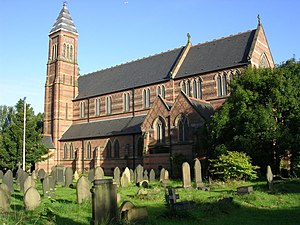Church in United Kingdom
| Church of St Cross, Clayton | |
|---|---|
 | |
| Country | United Kingdom |
| Denomination | Anglican |
| Tradition | Modern Catholic |
| Website | www |
| History | |
| Dedication | Holy Cross |
| Consecrated | 1874 |
| Architecture | |
| Architect(s) | William Butterfield |
| Style | Gothic Revival |
| Years built | 1863-1866 |
| Administration | |
| Diocese | Manchester |
| Archdeaconry | Manchester |
| Deanery | Manchester North and East |
| Benefice | Clayton St Cross with St Paul |
| Clergy | |
| Rector | Fr. Chris Moore |
| Laity | |
| Reader(s) | Mark Robinson and David Onobanjo |
| Churchwarden(s) | Janet Towell and Doris Marsland |
The Church of St Cross, Clayton, Manchester, is a Victorian church by William Butterfield, built in 1863–66. It was designated a grade II* listed building in 1963.
History
The land on which the Church of St Cross now stands was originally in the parish of St Mary Droylsden. In the early 1860s the land was gifted to Revd. Charles Henry Lomax by Peter Hoare. The Gothic Revival architect William Butterfield was invited to draw up plans for the new church and construction began in 1862. At the time of construction, Bishop Prince Lee was in charge of Manchester Diocese. Lee, a low churchman, did not take to the ornate decorative style of St Cross and initially refused to consecrate the parish church, despite the opening services happening in 1866. Bishop James Fraser eventually consecrated the church in 1874. Originally, St Cross was built without many stained glass windows. On the closure of the Church of St Peter, in nearby Oldham, in 1970, sixteen of its stained glass windows were gifted to St Cross and are now located in the nave.
The churchyard contains the war graves of seven soldiers of World War I and two of World War II.
Architecture and description
The church is very tall, in Butterfield's trademark red brick, with blue brick and pale stone banding. The style is Middle Pointed. To the south-west, the church has a high tower, "narrow and tall, with slender angle buttresses and a steep pyramidal roof of banded slate, and a gabled south porch with 2-centred arched doorway".
The interior has lost most of its furnishings but remains "unmistakably Butterfield". It has a timber-framed roof with five-bay arcades, with patterns of coloured stone and tiles that have been echoed in late 20th century stencilling. There is some notable stained glass of the patron saints of the British Isles. The church is a Grade II* listed building.
See also
References
- "History of St Cross". 13 June 2023.
- "CWGC Cemetery Report". Commonwealth War Graves Commission. Retrieved 20 November 2024.
- ^ Hartwell, Hyde & Pevsner 2004, pp. 362–363.
- ^ Historic England. "Church of St Cross, Ancoats and Clayton, Manchester (Grade I) (1283072)". National Heritage List for England. Retrieved 20 November 2024.
Sources
- Hartwell, Clare; Hyde, Matthew; Pevsner, Nikolaus (2004). Lancashire: Manchester and the South East. The Buildings of England. New Haven, US and London: Yale University Press. ISBN 0-300-10583-5.
External links
| Churches in the Deanery of Manchester North and East | |
|---|---|
| Benefice of Birch-in-Rusholme |
|
| Benefice of Blackley Holy Trinity |
|
| Benefice of Blackley St Andrew |
|
| Benefice of Blackley St Paul |
|
| Benefice of Blackley St Peter | |
| Benefice of Burnage | |
| Benefice of Cheetham and Lower Crumpsall |
|
| Benefice of Clayton | |
| Benefice of Collyhurst |
|
| Benefice of Crumpsall |
|
| Benefice of Gorton and Abbey Hey |
|
| Benefice of Harpurhey |
|
| Benefice of the Heatons |
|
| Benefice of Heaton Reddish |
|
| Benefice of Higher Openshaw |
|
| Benefice of Levenshulme |
|
| Benefice of Lightbowne |
|
| Benefice of Longsight |
|
| Benefice of Manchester St Barnabas |
|
| Benefice of Miles Platting |
|
| Benefice of Moston St Chad |
|
| Benefice of Moston St John |
|
| Benefice of Moston St Mary |
|
| Benefice of Newton Heath |
|
| Benefice of North Reddish |
|
| Benefice of Reddish | |
| Benefice of Victoria Park | |
53°29′00″N 2°10′55″W / 53.4834°N 2.1819°W / 53.4834; -2.1819
Categories:



